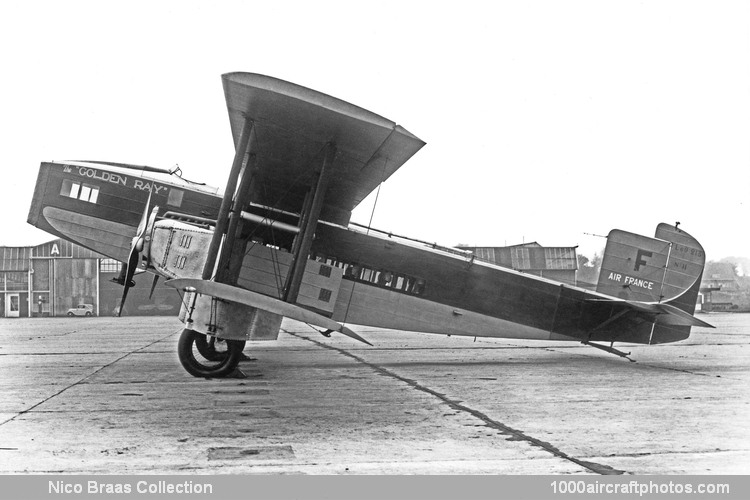04/15/2021. Remarks by Johan Visschedijk: "In 1926 Lioré et Olivier built a commercial version of its LeO 20 bomber. This was the LeO 21, which, like the bomber, was powered by two uncowled 420 hp Gnome & Rhône Jupiter 9Ab nine-cylinder air-cooled radial engines driving two-blade wooden airscrews.
The LeO 21 was a three-bay equal-span biplane with untapered wings, and its rather square-looking fuselage filled most of the gap between the wings. The wings were of metal construction with fabric covering and the fuselage was of mixed construction. The single wheels of the main landing gear protruded from streamlined trousers beneath the engine nacelles. There were ailerons on all four wing tips, and the upper and lower ailerons were connected by a single strut. The tail plane and fin were adjustable in flight to allow load and asymmetric thrust trimming.
There was a cabin in the nose for six passengers, with three windows round the extreme nose section, and a main aft cabin for twelve passengers. A passageway connected the two cabins and gave access to the cockpit and lavatory. The passengers' entrance door was on the starboard side aft of the wings, but some way short of the rear of the cabin. The fore and aft baggage holds had separate doors, also on the starboard side. The LeO 21 had dual controls and was equipped with radio.
The prototype, F-AIFD (c/n 1), received its CofA in August 1926 and was delivered to Air Union in the same month.
A second LeO 21, F-AIFE (c/n 2), appeared soon after the prototype, but in the first half of 1927 was re-engined with 450 hp Renault 12Ja twelve-cylinder liquid-cooled V-engines to become the LeO 212. These engines had almost circular radiators of fairly large diameter and drove two-blade metal airscrews. In collaboration with Cie des Wagons-Lits the interior was modified to a restaurant type with accommodation for twelve passengers, and there was a bar and barman. In large capital letters along the side of the fuselage was the text Avian Restaurant Londres-Paris-Marseille-Tunis, but both F-AIFD and F-AIFE were used on the Paris-London route, the first service being flown on July 30, 1927. These aircraft were named Capitaine Ferber and L. P. Mouillard respectively.
In 1928 the first of eleven LeO 213s appeared. This was F-AIVG (c/n 3). The LeO 213 had slightly increased span and a longer fuselage, with the cabin extended further aft. The fuselage was also strengthened, all the control runs placed outside, the windows in the extreme nose omitted and the forward cabin used for baggage stowage. The LeO 213s had the 450 hp Renault 12Ja engines, seating for twelve passengers in single seats on each side of the aisle, and all carried two pilots; but three of the aircraft were equipped with a bar and carried a steward as third crew member. In the LeO 212 restaurant aircraft the seats had been arranged in pairs on the port side and to form facing groups of four with a table in between each group.
The LeO 213s were painted in an attractive scheme of gold, red and white. The wings, tail planes, lower fuselages, fins, engine nacelles and landing gear fairings were gold; the upper part of the fuselage sides and the nose were red, and this red was swept up the rudder in a curve from the hinge to the trailing edge; the top of the fuselage was white except for a black anti-glare section on top of the nose, and the words AIR UNION were painted in white from nose to tail on the underside of the fuselage. These aircraft were used on the Paris-London and Paris-Lyons-Marseilles services under the fleet title le 'Rayon d'Or' (The Golden Ray). Three production aircraft were built in 1929 (F-AIZN c/n 4, F-AIZO c/n 5, F-AJBE c/n 6) and in 1930 (F-AJNS c/n 7, F-ALCS c/n 8, F-ALCY c/n 9), and the final four were produced in 1931 (F-ALGF c/n 10, F-ALGG c/n 11, F-ALGH c/n 12, F-ALGI c/n 13).
In 1929 F-AIFD was refurbished as a twelve-passenger aircraft with bar and barman, when it became a LeO 211; but in 1931 it was fitted with Renault engines and redesignated LeO 213.
F-AIFD and F-AIFE were converted to cargo carriers in 1932 and 1931 respectively, and later at least two other LeO 213s were used for cargo. F-AIVG was for a time fitted with 500 hp Renault 12Jc engines and in 1932 F-AJNS (c/n 7) had 500 hp Renault 12Jb engines with left- instead of right-hand rotation.
When Air France was formed in August 1933 it took over eleven of the LeO 213s. F-AIVG crashed into a radio mast at Croydon when taking off on a cargo service on May 31, 1934, and in October that year nine were taken over by the French AF after they had each been modified to carry twenty troops.
A number of the LeO 213s had been equipped for night flying while in Air Union service and these bore the designation LeO 213N. They had reinforced floors, larger doors, non-sliding windows and modified fuel systems. In Air Union and Air France service the thirteen aircraft achieved a total of 20,000 flying hours.
